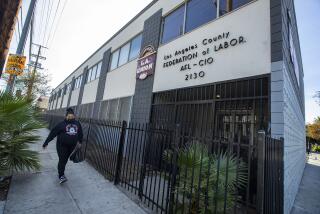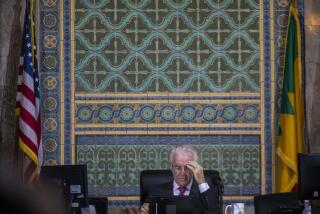TV Gives Pomona a Whole New Look at City Officials
THURSDAY
Dec. 21, 1989
7:00 p.m. Pomona City Council
Miniseries; 4 to 6 hours Mondays.
Iron-willed mayor (Donna Smith) is raked over coals by irascible, tough-talking councilman (Clay Bryant) and other colleagues. She strikes back. Town gadflies take sides, applaud, jeer.
Well, it’s not “Dallas.” But for those who tune in to weekly cable television broadcasts of Pomona City Council meetings, there is a rich array of strong personalities in continual conflict.
There are dull interludes, of course, when the talk turns to a lot split or a contract for curb and gutter repairs. And some of the guest stars--residents who pop up from the audience week after week to address the council--tend to repeat themselves.
But where else can viewers watch their neighbors stride to the podium, look at Councilman C. L. (Clay) Bryant, and call him a “puppet master,” “Fuhrer” and “pompous ass?” Or tell Mayor Donna Smith: “You look like a possum eating green grapes”? Or hear Bryant respond to an accusation of drunkenness by promising to pay $1,000 to anyone who can prove that he was ever drunk in his life?
And that’s just the dialogue from last week’s show.
The A. C. Nielsen Co. does not measure the audience for the Pomona council meetings on Monday night, but Councilman Tomas Ursua claims, “We’re beating ‘Monday Night Football.
“Maybe not when the Rams play the 49ers,” he admits, “but when you have some of those Midwestern teams with a lot of losses.”
And Pomona’s isn’t the only San Gabriel Valley City Council with a television following. Six others televise meetings, and two more are slated to start after the first of the year.
In Azusa, where council meetings have been available on cable television since 1980, Arthur Ramirez, production manager for Falcon Cable, estimates that as many as 25% of the subscribers will tune in if there is a highly controversial topic on the council’s agenda.
“It’s the most popular thing we have,” Ramirez said. “People have told us they have signed up for cable just to watch the council meetings.”
In Glendora, the City Council voted 3 to 2 last month to begin televising its meetings, but delayed the start until after the April city elections. Councilman Larry Glenn, who voted against televising the meetings, said he fears that cameras will invite “grandstanding.”
Pasadena Mayor William E. Thomson Jr. said his city’s experience with regular cable coverage of meetings of the Board of Directors has been “very positive.” He said he has been surprised at how many people say they watch.
“When I was campaigning for election this year,” Thomson said, “people would say, ‘Oh, I know who you are. I’ve seen you on cable.’ ”
In Pomona, where a recall campaign is under way against Bryant, political acrimony has increased lately, and so apparently has the size of the council’s viewing audience. “Over the past year or so, (the broadcasts) have gained in popularity,” said Steven Perry, community programming director for Continental Cablevision, which has 13,000 subscribers in Pomona.
The company undertook a survey this year and found that 60% to 70% of its subscribers tuned in to community programming at some point during a one-month period. During one 24-hour period, more than 30% of the viewers said they spent some time watching Channel 3, the community programming channel whose primary telecast during that time was a council meeting.
Victor Laruccia, former television administrator in Pasadena and now a consultant on cable television, said a survey of Pasadena cable subscribers a few months ago found that 60% had watched local cable programming and 40% had seen sessions of the city Board of Directors.
Ann Pursel, president of the Pasadena school board, said she used to watch the Pasadena city meetings about twice a month, but her viewing has declined because the city board now meets on the same day as the school board. Too bad. She used be able to watch and “get my ironing done at the same time.”
Still, cable television reaches less than half the homes in the San Gabriel Valley.
“I find it not too exciting,” said Richard Klingbail, a manufacturer who lives in Pasadena who said he has watched council proceedings on TV but has no plans of becoming a regular viewer. “They keep hashing the same thing over and over.”
Laruccia said the Pasadena spends $15,000 to $18,000 a year to televise city board meetings.
Craig Watson, regional general manager of the San Gabriel Valley’s largest cable company, Choice Television, which serves Pasadena, West Covina and much of the western San Gabriel Valley, said Pasadena’s coverage, which uses three cameras, is fairly elaborate. Some cities cut costs by depending on volunteers to run the cameras or by installing fixed cameras that can be operated by remote control.
At the other end of the cost spectrum, in West Covina, cable coverage will begin next month for less than $150 per meeting, said Anna Murphy, city cable coordinator. Murphy said the price is low because it requires only two technicians. Murphy said West Covina does not yet have the technology to broadcast meetings live.
Council meetings are broadcast live in Azusa, Monrovia, Monterey Park, Pasadena, Pomona, Sierra Madre and South Pasadena.
The televised meetings sometimes increase live attendance. Irate viewers have been known to jump in their cars and rush to City Hall to voice views on topics under discussion on the tube. In Norwalk last year, a resident watching the council discuss plans for a huge sign along the 605 Freeway was alarmed to see little opposition expressed. He raced to the council meeting in time to persuade the council to reject the proposal, cable executives proudly recounted.
As municipal government enters the television age, there have been some glitches. In Monterey Park, one councilman complained a few years ago that the cameras always seemed to catch him when he had his hand to his nose. And another Monterey Park council member, who thought his microphone had been turned off, offended some viewers with profane language.
In El Monte, the City Council permitted coverage of one meeting a few years ago as an experiment but didn’t like it. City Administrator Greg Korduner said the council complained that there were “cords running across the floor, and people were tripping on them.” The council permits telecasts on an “as-needed basis,” Korduner said, but added that the need has never arisen.
Korduner, formerly administrator of South El Monte, said that city also tried and rejected cable coverage--because council members complained that the television lights were too hot.
When Arcadia City Council meetings were televised in the 1970s, Councilman Charles Gilb said: “A lot of people came to the meetings just to get on television.” The coverage was discontinued during a cable company reorganization, Gilb said, and there has been no demand for its resumption.
Some city councils have hesitated to permit cable coverage on grounds that speakers might pander to the television audience.
In Pomona, where council sessions have increasingly become platforms for politics, it’s of particular concern.
The council’s policy is to allow the public to speak briefly on any item on its agenda. At the end of the meeting, the council sets aside time to hear anyone from the audience speak for five minutes.
Supporters of the Bryant’s recall have taken advantage of the time to encourage members of the television audience to sign recall petitions. Meanwhile, Bryant’s supporters have used their speeches to the council--and the television audience--to praise Bryant for his work and to assail his chief political opponent, Smith.
Bryant said that under the City Charter, comments from the public should be confined to grievances and “suggestions for the improvement of city affairs” but that people instead are taking the opportunity to deliver “a lot of invective and lies.”
Bryant himself uses the council meetings to attack his political opponents, and is being sued by two police officers for remarks he made about them during a council meeting. The suit noted that Bryant’s remarks were heard not only in the council chambers but by residents throughout the community, via cable television.
More to Read
The complete guide to home viewing
Get Screen Gab for everything about the TV shows and streaming movies everyone’s talking about.
You may occasionally receive promotional content from the Los Angeles Times.






